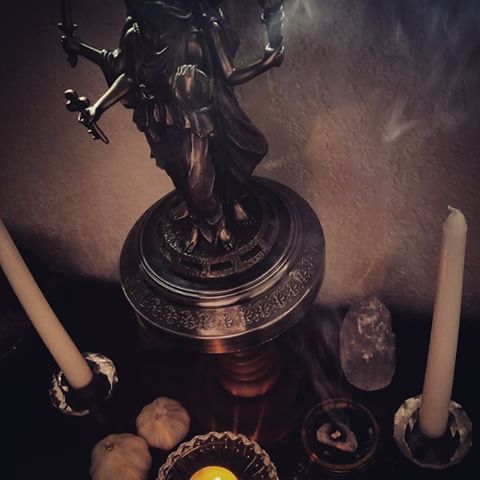Noumenia is held a day after the new moon usually, as the first sickle of the moon shows.
This is a separate celebration from the new moon celebration and Deipnon held in honor of Hecate.
This is a smaller scale celebration, than the ones held in public in the ancient Greece, where all the Gods were invoked and the offerings brought to them.
Noumenia is the day where no other rituals were held and it was known as the day of incense burning. Different resins and herbs were burned in front of the depictions of Hecate as a sacrifice. Additionally, different food connected to Hecate was also placed on the altars: garlic, honey, cheese, sometimes fish and eggs, olive oil, wine, honey cakes, bread.

Prepare a paper for writing down your intentions for the next month, and possibly a symbol or sigil that will represent your goal (a stone, chestnut, a couple of seeds, drawn sigil, clay figure, dried or fresh flower, garlic clove…)
Before opening the circle, cleanse the area. For new moon, the water was used, sometimes bowls with water were left in front of the shrine entrance, for the attendants to wash their faces and hands. At home, it is enough to sprinkle water and salt and to smudge around the circle. Walking around the circle deosil is important even before the ritual starts, since it symbolizes the movement and passing of the previous month, and stepping into the next.
Cast the circle and invoke Hecate as you do so.
There are many invocations, so I’m leaving this one to you. I have my own invocation that I use, and also a hymn, used later in the ritual. If you’re working with single deities, it’s always better to write your own hymns and prayers, since they hold the most of your energy and relationship with the deity.
Mine goes as following:
Hecate Triodia, I call upon thee, step into my circle, Dark Mother. Bring your light in and touch me with your Wisdom,
open the gates that I need to step through,
feast on the meal that I laid before you,
join me tonight, in the night of New Moon and new beginnings.
Light the incenses in Her honor or place the resins on the charcoal and take some time to feel the Goddess and connect.
Place the offerings on the altar or Hecate’s shrine, if you have one separate from the altar. Light the candles (I am using a dark grey or purple candles when working with Hecate on new moon). Bless the offerings.
This is the time to perform the rite with your hymn.
For me, each part of the hymn is sort of a lead on what to focus. Roughly divided, one part focuses on the past and my path toward meeting Hecate, another part reminds me of my goals and what I strive for in life and the final part is focusing on the present. To be into here and now, to question if I’m doing it right, to remember that life is about joy same as about growing through suffering. That all comes from the Dark and wise Mother as a lesson.
After first part, I usually take time to reflect on the past obstacles I overcame and what was left of them in me.
After the second part I usually write my intention down, short form, mostly minimized into a single sentence. I use no negative definitions when doing this. Remember, saying “I don’t want to… ” pulls energy toward the past and gives energy to the exact thing you don’t want. If you define your wish as: “I want..” or “I want something (different)” and there lies your focus, you’ll be moving forward.
After the third part of the hymn I connect the object or sigil to the intention I wrote before. Then I thank Hecate for taking part in my ritual and (in my mind) hand her the offerings. After that I burn my written intention for the next month. As it’s important to write down the intentions and have a clear definition of them, it’s as important to also let them go. If you cling onto them, you’re in the way of them coming true. Yet you can wear your object or sigil with you, or you can leave them on the shrine to remind you of your way.
Different practitioners do the rite differently and there are endless possibilities. I tend to keep everything simple with Hecate. She is the wise Mother. She doesn’t need (in my humble opinion) hour-long hymns, seasoned with bows, butterflies and shiny stars. She is straight forward and realistic, and I am keeping it the same. From almost 20 years of working with her and worshiping her, I’ve had a bunch of experiences, and too nicely packed up stuff tended to make her uninterested or sometimes unresponsive – other than being present.
As said, this might be different for everyone, it’s just important to find and keep up your relationship with the Goddess (or any deity you choose to work with).
After the rite is over, I thank Hecate for being there and if performed within the coven, we usually share some of the offerings (not ones on the altar, but separately prepared ones for us – you don’t use same plate as you put the offerings on, nor you take the offerings from the Goddess). This is the Noumenia feast part, and can also be performed with a whole family after the circle is closed.
After I close the circle, I leave the offerings a little longer on the shrine and then take them to the nearby crossroads and leave them next to a tree that I chose. The ashes from my burnt intention and a lit incense are also placed next to the offerings. Some old writings advise that one doesn’t turn around after leaving the offerings, but should head straight home.
In the following night, I am usually having many unusual and realistic dreams. It became a common thing for me, and I’m always looking forward for more messages from Hecate, in any form.
Blessed be!


 We’ve met with the intention to do a guided meditation with the clear goal to find out more about ourselves.
We’ve met with the intention to do a guided meditation with the clear goal to find out more about ourselves.